|
|
Rock
Candy
This bead head caddis
imitates the cased caddis throughout our river system has been
very effective on the wild Upper Delaware River 'bows in the
fast riffles when tied tandem with an emerger. They are
available in #12, #14 and #16.
|
HENDO
One of a series of
emergers that I tie with snowshoe rabbit for the wing, Z-Lon for
the shuck and a tannish dubbing for the abdomen. This pattern
imitates the early spring hatch - The Hendrickson - which makes
its appearance in late April through mid May during mid to late
afternoon..
|
|
March
Brown Emerger
Another excellent
snowshoe emerger pattern which the trout find real buggy and
irresistible. I tie this pattern large - either in size 10 or 12
and will fish this tandem with a bead head pattern on top.
|
The
Admiral's March Brown
One of my favorite
hatches is the March Brown - a large mayfly in size 10 or 12
which will hatch in the Catskills / Upper Delaware River region
from mid May through early June depending on how cool and wet
our spring has been. This fly is a Sparkle Dun with Coastal Deer
Hair along with a sparse tuft of Z-Lon for the wing, Z-Lon for
the shuck and a ribbed tan body to complete this juicy fly.
|
|
Sparkle
Sulphur
Early June is Sulphur
time on the Big D.! And this dry has caught many wild browns and
rainbows when the hatch is in full swing. I'll tie this fly in
size 14 through 18 and will also vary the color of the abdomen
since sulphurs will change from a lemon yellow to a pinkish /
orange cast depending on the river location. Z-Lon for the
shuck.
|
Uncle
Wabbit's Snowshoe Sulphur
Well, the name may
sound silly, but this fly tied in 16 and also in 18, is like
candy to the wild rainbows. The Big D. has some major sulphur
hatches in the spring, summer and fall and most times the fish
will key on the smaller mayfly like this sweet sulphur. This fly
is pattered after Fran Better's "Haystack" and "Uusal"
with a Z-Lon shuck and Spectrum Dubbing for the body and
snowshoe rabbit for the wing.
|
|
The
Admiral's Sulphur Spinner
The third and last
stage for any mayfly is the spinner. These spinners grow
translucent wings, their tails become longer and they fly back
to drop their eggs over riffles and then die. The spinners then
drift down to tail-outs where they are an easy meal for the
trout and are devoured. Spinners, either Rusty or Sulphur, are a
must in every anglers flybox at dusk.
|
The
Admiral's Dress Grey Caddis
'Ten hut! One of the
most successful Caddis patterns in recent times is The Dress
Grey Caddis. The pattern resembles the X-Caddis with a few turns
of grouse or partridge for the legs, Coastal Deer Hair and a
dubbling to match the caddis that's on the water. Grey, Olive
and Tan are all great colors in size 12, 14 and 16.
|
|
The
Admiral's Olive Parachute
The Blue Wing Olive,
or Baetis, is a staple throughout the fishing season on
the Upper Delaware River and all Catskill streams. I find that
they appear on overcast, and drizzly days - humid with no wind
is the best, and depending on the time of year are a variety of
sizes. You'll find the larger size 14 Cornutas in June
and smaller species of the BWO's like 18's and 20's in the fall.
The fly pictured is The Admiral's Olive Parachute, which is a
great pattern since it is easy to see with a nice white Z-Lon
post and this pattern sits flush in the film presenting a
vulnerable meal for the wild trout on the feed.
|
Baetis
Greatis
Similar to the
Sulphur Sparkle Dun is Baetis Greatis. The only difference is
the color of the abdomen and body which is olive grey to match
the natural on the water. I'll tie these flies from size
14 through 20 and are very effective on selective trout that are
cruising the large deep pools that the Upper Delaware River is
known for. Some of the largest fish that our guests have caught
have been on size 18 BWO's like the Baetis Greatis as well as
BWO CDC's and Comparaduns.
|
|
Rusty
Spinner
This old standby is
the Rusty Spinner which can be tied from size 12 all the way
down to size 18. The spinners are the last stage of the maylies
life cycle and they're great patterns at dusk or overcast days
when the trout are sippin'. Most maylie's bodies will turn a
rusty burgundy color and their wings become translucent like
glass. I use a sparse amount of white crinkly Z-Lon for wing
tied splayed and Microfibbetts, also splayed downrigger style
for the tails. A little ice dub for the thorax works like
a charm and seems to turn even the most fussy fish on.
|
STONED
One of the first
flies that hatch in the Catskills and that trout look up in the
early spring is the Early Black Stonefly. It's really a dark
brown and is tied in a size 14 and 16. This pattern has been
very effective using a brown CDC for the legs, Moose for the
tail, Grizzly hackle folded over to make the elongated tent wing
and some black/grey dubbing material to round out the fly.
|
|
The
Admiral's Revenge
Here's another Baetis
pattern which has proven over the years to be very effective on
the browns and rainbows on the Upper Delaware River. It's a
hybrid - using snowshoe rabbit for the wing and Microfibbets for
the tail along with a nice tapered body in an olive dubbing.
I've added a touch of green icedub within the olive dub for the
thorax which seems to turn the fish on. Fish On!
|
Little
Sulphur
If there were two
mayflies that you would want to have in your fly vest throughout
the trout fishing season, one would be the Blue Wing Olive and
the other would be a Sulphur. Here's "Little Sulphur".
The same receipe as "The Admiral's Revenge" on the
left but this time the body and thorax are a lemon yellow with a
tad of ice-dub to complete this fly pattern.
|
|
Caddis
Snowshoe Sparkle Pupa
The Main Stem of the
Upper Delaware River has plenty of Caddis. Look underneath the
small rocks in the river and you'll find plenty of cased caddis.
In May, these bugs dislodge from their cocoon and make their way
to the surface. Gary LaFontaine designed the Sparkle Pupa
back in 1974 and this adaptation uses a little green floss
tapered to a strip of green UV Chewy Skin for the body, crinkly
Z-Lon for the gassy bubby and snowshoe rabbit for the emerging
wing. Don't forget to pack this fly!
|
Caddis
Beadhead Snowshoe Sparkle Pupa
This is the same
recipe as the the fly on the left, but sometimes the fish prefer
a little flash so we put a beadhead on this Snowshoe Sparkle
Pupa plus it gives the fly a little weight if you're using it
trailing a pheasant tail, Brassie, Copper John or Prince Nymph
in the riffles for the wild Upper Delaware rainbows. Size 12
through 16.
|
|
Snowshoe
Hendrickson
The first mayfly
hatch in the Catskills which is anticipated eagerly by all dry
fly anglers is the Hendrickson. This meaty fly starts out as a
size 14 and as the hatch progresses into May will drop down in
size to a 16. Either the Red Quill or the Hendrickson are
excellent patterns tied either in CDC or snowshoe rabbit. The
hatch begins in late April and the flies will be on the surface
starting at 3:00pm. This hatch is so reliable that you can set
your watch to when the bugs come up. A hatch not to be missed!
|
Snowshoe
Red Quill
The male bug of the
Hendrickson is the Red Quill which appears during the same time
period as the lighter female (to the left). It's best to have
both the male and the female on the water since the fish can, at
times, be fussy. Here's a great pattern using red quill for the
body segmentation and a light dun showshoe for the wing.
|
|
Big
Bad Red
And yet another
pattern of a Red Quill mayfly which will hatch with the
Hendrickson in the Catskills from late April through mid
May. I tie these in size 14 and 16. The difference in this
pattern from the Snowshoe Red Quill seen above to the
right is that this wing is a darker dun of snowshoe rabbit
and the thorax is twisted strands of pheasant tail which has a
rusty brown cast. They both work.
|
The
Majesty
Here's
an early season pattern which is the first mayfly to arrive in
mid to late April. The diminutive size 18 Blue Quill. We
see this hatch appear around midday and many times wild trout
will turn on to these morsels. They're small...but they are
effective and will bring some 20+ inch brown trout to the
surface! Blue Quill for the body, grey Hare-Tron dub for a nice
built up thorax and snowshoe rabbit for the wing with a trailing
shuck.
|
|
The
Majesty (Alternate Wing)
Another version of "The
Majesty" but this time I've used a lighter dun color
for the wing as opposed to the dark dun / medium grey found in
the above right photo. Depending on glare, contrast, foam lines
and light conditions, a lighter wing might make the difference
in hook ups so why not make the same pattern with a slighty
lighter wing color. FISH ON!
|
ESP
This is an alternate
take on Gary LaFontaine's Emergent Sparkle Pupa of the common
caddis that the Upper Delaware River has plenty of. These bugs
hatch in April through the month of May are are very common on
the Main Stem where there are blizzard hatches. I've used some
pearl tinsel for the body which glistens as well as ultra fine
Z-Lon for the emergent bubble for the pupa. Sizes: 12
through 16.
|
|
RF
Caddis
Here's a simple but
very effective pattern which simulates a caddis dry. Tied in
sizes from 12 through 16 and the body can be either green, tan
or grey to imitate the abundant naturals. The RF Caddis,
hat tip to Rich Strolis of Connecticut, uses snowshoe rabbit for
the wing as opposed to elk or deer hair but has much more
buoyancy in the riffles and runs of the Main Stem UDR.
|
X-Caddis
The X-Caddis was
designed by Craig Matthews at Blue Ribbon Flies in Montana to
simulate the vulnerability of the caddis with the trailing shuck
of Antron or Z-Lon. This time I've used a sparse amount of
Coastal Deer Hair for the underwing and then a sparse amount of
snowshoe for the emergent wing.
Vary the size from 12
to 16 along with the body in tan, olive and grey to match the
natural. A bit of ice dub for the thorax and you're ready for
the water!
|
|
Tan
X- Caddis with / without Egg Sac
I'll tie those
X-Caddis in three basic colors for the body dubbing: tan, grey
and green to imitate the natural that's hatching on either the
West Branch or the Main Stem. Around Mother's Day in early to
mid May, you'll find the Grannom laying eggs so it's always a
good idea to tie a few alternates as well. These patterns
have sparse Coastal for the wing and a little bit of
snowshoe. Sizes: 14 and 16.
|
Breakout
Hendrickson Emerger
This pattern, "Breakout
Emerger", was originated by Loren Williams and can be
tied on a scud hook - here a Daichii 1150 - in different sizes
and body colors to match a specific mayfly. I've tied this
pattern to tie an early season Hendrickson in size 14. Body is
pheasant tail with strands wound like rope and then overwrapped
with fine gold wire. Dun snowshoe for wing and fine Z-Lon for
the loop wingcase. Partridge: legs and tail.
|
|
The
Lordville Poo-Pah
The Poo-Pah was
originated by Tim Fox on the Sacramento River in California and
also works very well as a caddis imitation on the Upper Delaware
River on those wild and strong 'bows. I will tie these patterns
in sizes 12, 14 and 16. Body colors are in tan, green and
grey to imitate the naturals that our river has plenty of.
Peacock herl is used for the collar and micro chenille for the
body. Partridge for legs and an underbody of pearl tinsel
with fine gold wire segmented. Fish these patterns in the
oxygenated riffles and pockets either solo or on a tandem rig
with an emerger or attractor.
|
The
Lordville Poo-Pah (sans perle)
Here's the same fly
pattern as on the photo on the left, which has been a great
nymph / emerger (depending on the weight of the fly) on the Big
D with the wild rainbows tied this time without the bead.
A side view and top view. I've added some black ice dub
touch dubbed loosely for the thorax before adding the peacock
herl rope collar giving it a buggy scraggly look.
|
|
Miss
Mary Meeker
Nymphs play an
important role in any flyfishers success astream. Throughout my
years on the Upper Delaware River, my three favorite nymphs are:
Prince Nymph, Pheasant Tail and a Copper John. I usually tie
these in sizes 12 and 14 along with a gold bead since the river
is big and the velocity is swift which means you've got to get
these nymphs down in the water column and they have to be large
enough for the fish to eat. An adaptation of these three
patterns is "Miss Mary Meeker" which employs
Pheasant Tail, Peacock Herl / Ice Dub, Partridge and fine red
wire weighted with a gold bead.
|
Prince
of the Upper Delaware
Besides a Pheasant
Tail pattern, another great nymph pattern is the Prince
Nymph. Tied either with a bead or without, the fly has
taken more than its share of feisty wild 'bows in the riffles on
the Big D. I believe the success of this pattern is the
peacock herl which can also be found in Brassies, PT's and
Copper Johns as well. I tie these weighted in sizes 10, 12 and
14. Just looking at this fly reminds me of the many stoneflies
that get dislodged and eaten by the trout. Make sure to have a
few of these in your flybox!
|
|
Goldfinger
Here's a spin-off to
the Prince nymph. Same configuration except I use a Czech
braid instead of peacock herl for the body. This fly is a great
imitation for the Yellow Sally, a small golden stonefly that
makes its appearance on Catskill streams and rivers like the Big
D in late May and early June. That's not to say that you can't
fish it on a tandem with the standard Prince early in the season
since the fish sometimes want variety and this pattern provides
it. I tie these weighted with and without a bead using a
gold biot and fine green wire in sizes 10 through 14.
|
Doctor
Copper
A hat tip to John
Barr who designed the Copper John, one of the best nymph
patterns that I've used in the Catskills and Upper Delaware
River for many years. The above photo is a slight
adaptation to Mr. Barr's bead head nymph using a longer hook, a
Dai - Riki #270 3X Long. I try to make the peacock herl
thorax a bit larger and fuller and the body of either fine red
copper wire or gold copper wire slimmer. This fly is made
in sizes 10 through 16.
|
|
Poor
Fred.
Every angler knows
about the Gold Ribbed Hare's Ear - it's a staple in every
beginning flyfishers kit. Why? Well, because it's a time proven
pattern that works! Here's my version of the GRHE called "Poor
Fred".
I tie this nymph
weighted with and without a bead in sizes 10 through 16. Turkey
flat for the bulging shuck, fine gold ribbing with Hare-Tron
dubbing for the sleek body, lemon wood duck for the tail and a
mix of hare's ear and a dark brown buggy for the thorax, the
ever present partridge for legs and topped off with golden
brown ice dub to give it little sparkle which is one thing Poor
Fred doesn't have. Tie one on this spring!
|
Purcell's
Fancy
This is a very
effective mayfly nymph pattern that is tied either with or
without a bead. It's an offshoot of the venerable Pheasant Tail
created by Frank Sawyer in the U.K. The patterns calls for four
pheasant tail fibers for the tail and body with fine gold wire
wound like rope and also peacock herl for the thorax. For the
shuck, I've switched to mottled turkey wing which is more
subdued and added partridge for the legs topped with a bit of
orange ice dub for the head. You can also fish this tandem with "Poor
Fred" or "Prince". Sizes: 10
through 16.
|
|
Gordo
"Gordo" - a
very successful parachute style tie which incorporates a
trailing shuck made of Antron, quill dyed blue / grey, grey
dubbing, a white Z-Lon post and dun rooster hackle. The hook can
be any dry fly style. I use a Tiemco T100 on a size 14. Quill
Gordons are the first large mayflies to appear on very clean
oxygenated rivers before the Hendrickson / Red Quill hatch and
are the same size, but the QG coloration is more grey and they
have two tails whereas the Hendrickson has three tails and a
more distinct reddish / tan / grey cast. A hat tip to Theodore
Gordon - the yank that started it all!
|
Iso-Iso
Pictured above is an Isonychia Emerger that can be fished as a trailer to a heavier bead head nymph or on its own. I tie these flies in sizes 10 and 12 on a scud hook and the trout will agressively strike these wet flies, or, emergers, as they swing in the fast riffles where the naturals hatch and swim as they become duns.
The time for Slake Drakes, or Isonychia, is summer and fall. You'll see these bugs hatch when the water is in the 50s to mid 60s mostly on humid and overcast days in the afternoon.
Besides your arsenal of Blue Wing Olives and Sulphurs...be sure to have a few Iso-Iso's as well as Snowshoe Iso's!
|
|
Cactus
Razzy
"On the cover of
The
Rolling Stone?"
Well, not quite... but this caddis pupa
pattern has caught more than its fair share of wild 'bows on the
Main Stem and was inspired by an old sage to the river valley as
well as a sharp talking Rolling Stone alumni. This guy is like Narrowsburg's version of Howard
Hughes and Rube Cross combined...very secretive but talented. This gent
has an ability to put a spell on the fish and I was privileged
to learn the ways of Ol' Cactus recipe which uses a mix of Ice Dub
and Z-Lon. When this fly is submerged in the fast
oxygenated water, the
mix of Z-Lon, sets off an incredible array of trapped bubbles
triggering vicious strikes from the fish thinking it's a pupa
which has become dislodged in the water column. Can be
fished solo or tandem.
|
Breakout
March Brown Emerger
Another great pattern
designed by Loren Williams (I have a sample of the Hendrickson
Breakout Emerger a few rows up).
Just change the
coloration and size to match the hatch and you're all set!
I fish these emergers
in the film solo or also as the dropper about eight inches
behind a bead head nymph in any pocket or riffle that has
oxygen...and trout!.
A proven and
excellent pattern on the Big D.!
|
|
LaFontaine's
Emergent Sparkle Pupa
Tiny Bubbles!
Yes, those loose
strands of antron when Gary LaFontaine's superb pattern, the
ESP, is submerged in the water column emits tiny bubbles as the
caddis pupa swims upwards towards the surface to break free of
its shuck to become an adult caddis fly. During this time the insect becomes
very vulnerable and the trout know it! I'll tie the ESP in sizes
12, 14 and 16 in tan, grey and green. Materials consist
of: Antron, touch dub a mix of sparkly antron with dubbing
material in your choice of caddis colors, coastal deer hair for
the wing and finish it up with a darker color for the
head. A very effective pattern for the Catskills and can
be fished tandem using a larger Elk Hair Caddis greased with
floatant for the top fly
and the ESP for the trailer. About 80% of the time, the fish
will whack the ESP!
|
Bird's
Nest X-Caddis (with egg sac)
Here's a hybrid of
Craig Matthew's X-Caddis with it's antron and coastal deer hair
along with the coloration and materials of The Bird's Nest, a nymph pattern,
created by Cal Bird in 1959 when he fished the Truckee River in
California and Nevada. The fly has excellent durability,
floats well in the surface film and I've touched dubbed the body
as well as the egg sac which glistens with small air bubbles
when in the water that triggers aggressive strikes. See
photo of LaFontaine's ESP in water on left. Tied in tan
(shown above), green and grey in sizes 12, 14 and 16.
|
|
Shad
Fly - General Geo.
Washington's Assortment
The American
Shad...or, if you're John McPhee, author of "The
Founding Fish" - he might use the Latin - alosa sapidissima.
But for us river junkies on the Upper Delaware River they also
go by the name:
"Poor
Man's Salmon".
Whatever you want to
call these fish, they are one hell of a fighter! Related to the
herring and tarpon, these fish leave the Atlantic Ocean in the
spring and return to fresh water rivers along the east coast to
spawn. Females - roe shad - will run up to 7 pounds and strip
line like a bonefish.
This
past season, Julia Grace Ketner, captured an IGFA All-Tackle (Length) World Record for American Shad.
This youngster caught this record fish with me on the Upper Delaware River on May 4 2013.
The Upper Delaware is
blessed since it is the longest free flowing river in the
northeast has no dams to obstruct the passage of these fish for
270 miles!
Shad will attack
weighted bright colored flies and streamers out of aggression
and the flies pictured have taken their fair share using colors
matched with those of President Washington when he fished this
river in the late 1700's. Try one and see -- FISH ON!
|
Goin'
Coastal
Gary LaFontaine's
breakthrough pattern, Emergent Sparkle Pupa, is one of
the best flies the angler can use either solo or tandem on the
Big D or West Branch Delaware River during the emergence of the
spring Caddis fly - whether they be Grannom, Charcoal, Popcorn
or Apple. I will tie these flies in grey, green and
tan to match the insect on the water. This version features
Coastal Deer Hair for the wing and not snowshoe as in the E.S.P.
seen a few rows above. In size 12, 14 and 16.
|
|
Admiral's
Tent Caddis
Another great pattern
is The Admiral's Tent Caddis using turkey quill for the mottled
coloration of the tent wing that is common for all grannoms and
caddis found throughout the Catskills and Upper Delaware River
Valley. I'll also add a bit of grouse for the legs which
makes the pattern even more buggy when immersed in the water.
This fly can be fished solo or also tandem with an ESP. A very
deadly fly available in green, grey and tan in size 12, 14 and
16.
|
Sulphur
Breakout Emerger
Many customers had
great success in the Catskills and Upper Delaware River region
with the March Brown, Iso and Hendrickson Breakout Emerger last
season and wanted me to tie a lighter version that could double
as a Light Cahill in size 14 or Sulphur or a PMD (like an Invaria
or Dorothea) in size 16 and 18. Here it is and
from the field tests in Argentina and Chile they have been very
effective this past winter both fished solo or on a tandem rig
on 5 or 6x. These will be proven winners in the late
Spring and throughout the summer on the tailwaters of the West
Branch. Available in #14, #16 and #18.
|
|
Soopa
Poopa
In honor of the 2014
Super Bowl, we bring you "Soopa Poopa" which is a
hybrid of two sucessful caddis patterns. The first is Gary
Lafontaine's Emergent Sparkle Pupa and the other is Tim
Fox's Poo Pah. The giveway is that nice micro
chenille butt along with a sparkle bubble that traps bubbles
under water and in the surface film. The flies were tied
in both green for the Seahawks and orange for the Broncos.
They've worked very well this past winter in South
America. Available in size 12, 14 and 16.
|
D.H.E.
Wow!
Here's a proven pattern that was originally designed by Canadian
born, now Scotsman, Bob Wyatt. Bob called it a "Deer Hair Emerger"
and if you look at Al Caucci's "Compara - Emerger"...it's
a dead ringer. What came first? Who cares? As long
as the pattern works. And work it does on the Upper Delaware
River.
It's an easier tie
than say a Klinkhammer without the parchute post - but just as
effective since it uses the abdomen of the fly submerged in the
water and the wing and thorax, which is touch - dubbed, creats a
more "buggy" appearance. Both wing and thorax
floats in the film waiting for a fish to nail it.
I tie the D.H.E to
match all mayflies (pictured above is a March Brown)
but vary the coloration and size. The
silhouette remains the same.
|
|
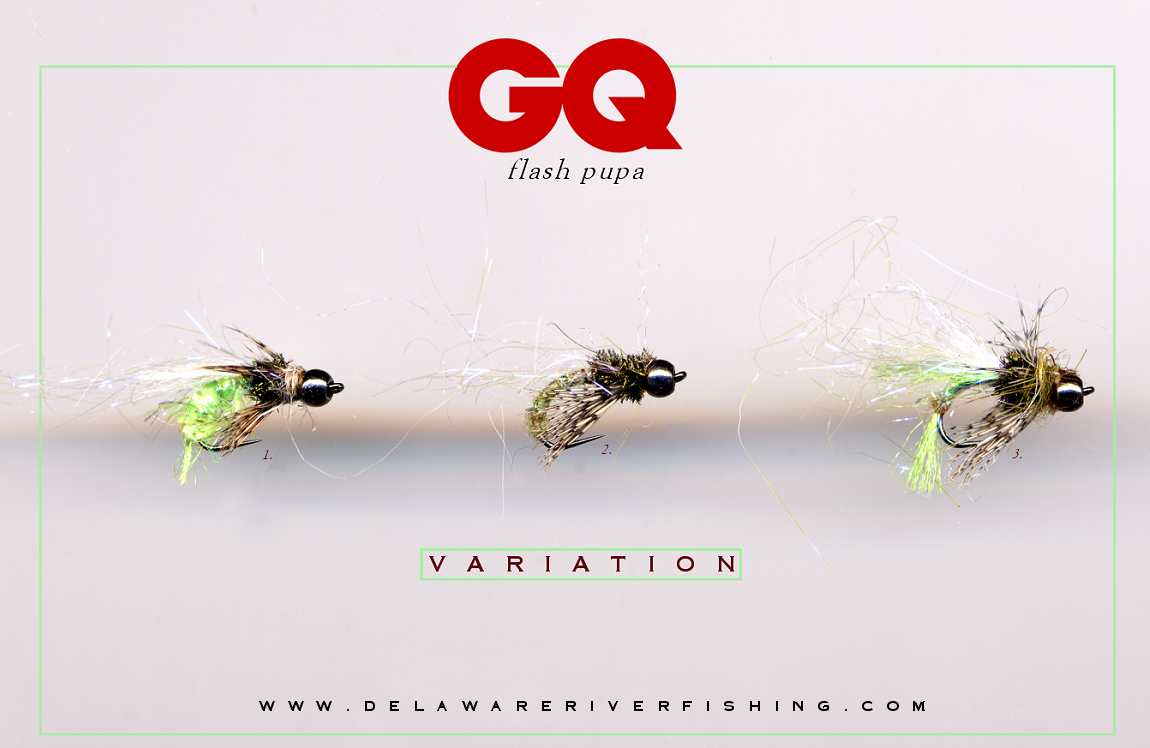
|
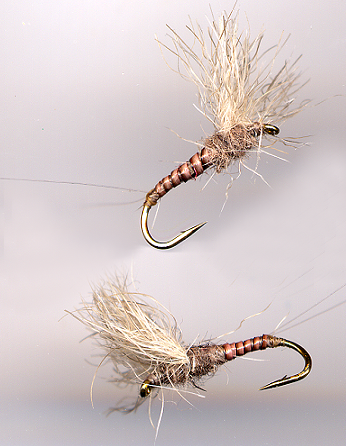 > >
|
|
GQ
Flash Pupa (3 Variations)
Caddis hatches play a
very big part of aquatic insect life on the Main Stem of the
Upper Delaware River where I have guided for the past twenty
years. Turn over any small rock in shallow riffles and you
will see thousands of casings attached to the bottom of rocks
which are the shelters for caddis larvae. The following patterns
have been very effective when fished in oxygenated riffles of
two to four feet when prospecting for wild rainbows. Try fishing
these with a larger prince or PT as the point and then tie a
size 14 or 16 (depending on current speed) as the dropper.
You'll be glad you did! Those 'bows seem to like the pupa.
Tight lines! Available in size 12, 14 and 16. Green, Tan
and Gray.
|
Snowshoe Quills
This dry fly uses
stripped peacock. I dye it to match the natural on
the water. Pictured above is the Snowshoe Red Quill.
The nice feature about this pattern is the slender body of the
fly with the segmented colors that imitate the abdomen of the
natural mayfly whether it be a Quill Gordon, Blue Quill, Red
Quill or Sulphur.
Rounding out the recipe
is Snowshoe Rabbit for the wing tied fan style, two Micro Fibbetts
for the tail splayed and a slight amount of fine super dubbing to
imitate the thorax of the mayfly.
This fly is a proven
winner.
Quill Gordon in size
14; Red Quill in size 14 and 16; Blue Quill in size 16 and 18;
Sulphur in size 16 and 18; Baetis (BWO) in size 16 and 18.
|
|
Prince
Nymph aka Bead Head Bernie
Without a doubt, a
Prince Nymph, with its' iridescent peacock herl is what the wild
rainbows on the Main Stem Upper Delaware River crave. To me, it
could resemble the nymph stage of the Isonychia or a small
stonefly nymph which the clean waters of the Upper Delaware
River are known for. I tie these nymphs with and without
beads - and weighted - in sizes 10, 12, 14 and 16.
This fly, also known in the Catskill region as "Bead Head
Bernie", along with the venerable Pheasant Tail, has taken
more than their share of trout from the skinny riffles from Long
Eddy south to Damascus. Don't be on the river without this
pattern!
|
Mandingo
(Caddis Pupa Series)
This fly pattern can
double as a sowbug or cressbug which is the primary forage for
trout in the spring creeks throughout southeastern Pennsylvania or
out west. However, it works just as well as being a caddis pupa
with the shell made of body glass and the fine grey ostrich herl
imitating gills protruding from the bottom. The head of this fly
is topped off with peacock herl for its wonderful iridescence that
wild rainbows love. Tied on a Daiichi 1150 hook in sizes 12,
14 and 16.
|
|
Gartside
Gurgler
The late Jack
Gartside of Boston was an innovative fly tyer who came up with
various salt and freshwater fly patterns that are now
legendary. He was an angler and designer that thought
"outside the box" and never took this great sport too
seriously.
The pattern pictured
above is the "Gartside Gurgler" which can be used on
both saltwater species like Reds, Specs and Stripers as well as
freshwater gamefish like smallmouth bass.
I tie these patterns
for the river bronzebacks who like to nail these topwater bugs
in the skinny riffles in August and September. A great fly!
Available in sizes 1,2 and 4.
|
Double
Gurgler
The same pattern as
pictured at left except this time tied with two strips of
closed cell foam which gives the fly a bit more support at the lip
along with more gurgle and splash to entice fish. I've also
extended the tail which is comprised of bucktail dyed to your
specs and a few strands of Krystal Flash and Sparkle Flash.
Tested throughout the
summer in the skinny oxygenated water and pockets for river
smallmouth bass under low light and windless conditions -- this
topwater pattern works like a charm.
NOTE: This fly
pattern can also be used for saltwater fish and is available in
sizes 1/0, 1, 2 and 4 on a Tiemco 300 hook.
|
|
Isonychia
- Breakout Snowshoe Emerger
The Upper Delaware
River and Catskill streams have plenty of Isonychia's, or Slate
Drakes, that hatch in clean oxygenated water throughout
the late summer and fall. Here's a pattern that I have
used with success either fished solo or tandem on a dropper in
the riffles before the emergence of the Iso's. Peacock swords
for the tail as in a Zug Bug. Tied in size 12 and 14.
|
Blue
Wing Olive - Breakout Snowshoe Emerger
Pictured above is
snowshoe emerger which is a great staple for the many species of
BWO's, or Baetis, we see hatching throughout the year in the
Catskills. I find that the Blue Wing Olives prefer overcast
days. These mayflies can vary from size 14 down to very small
22's in the late fall. This pattern is tied from 14 to 18 and
can double with an RS2 (seen below).
|
|
RS2
This great pattern
was created by Rim Chung on the South Platte River in Colorado
to imitate a Baetis, or small Blue Wing Olive, which are
prevalent on many tailwaters like the Upper Delaware River
system. The fly can be fished either as an emerger or nymph. It
is especially effective when trailed behind a parachute BWO, or
larger fly under low light conditions such as a Wulff. RS2's are
tied in sizes 18 and 20. On overcast days or when trout are
sipping and they refuse Rusty Spinners - throw 'em an RS2!
|
Hi-Viz
Parachute - Hendrickson
Take a look at this
flush floating pattern. Yes, it's a parachute for the
Hendrickson mayfly which will appear in the Catskills - Upper
Delaware River region in late April / early May.
However, I've also
added a Hi-Viz Antron post in chartreuse which is a great aid to
the angler both in glare and low light. I'll tie this style for
all mayflies - Hendrickson, Red Quill, March Brown, Sulphurs,
Cahills and BWO's.
More
flies will appear throughout the winter when I
am off the water.
If
you have questions or would like to order a few of these flies
to try next spring please feel free to contact me.
Tight
lines!
Tony
Ritter
845.252.3657
845.701.3894
- mobile
|
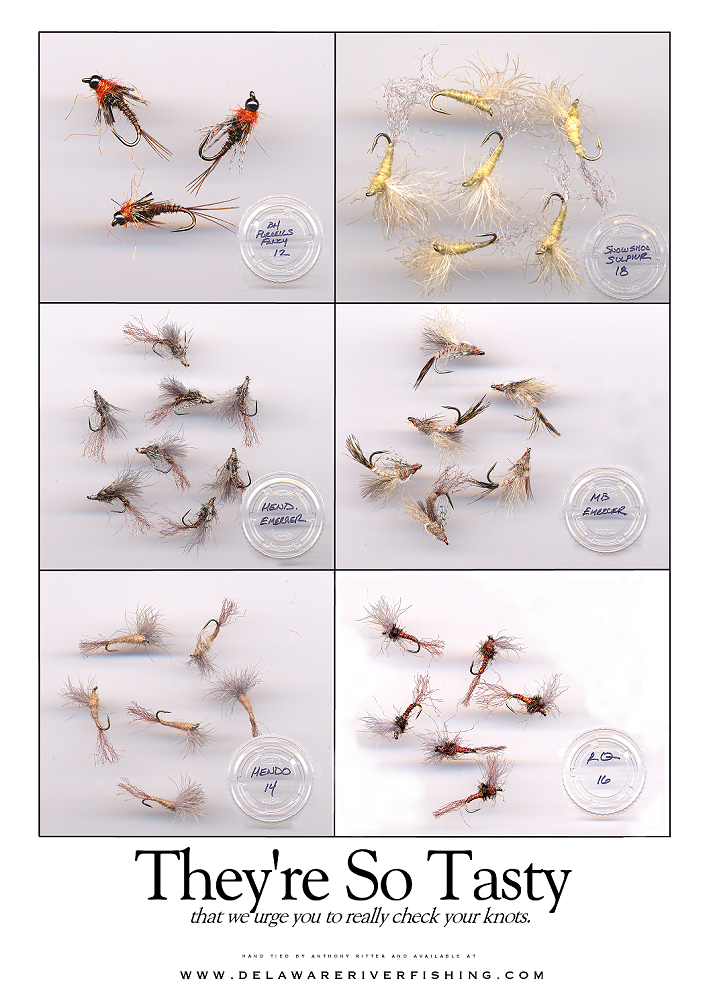
|
![]()
![]()

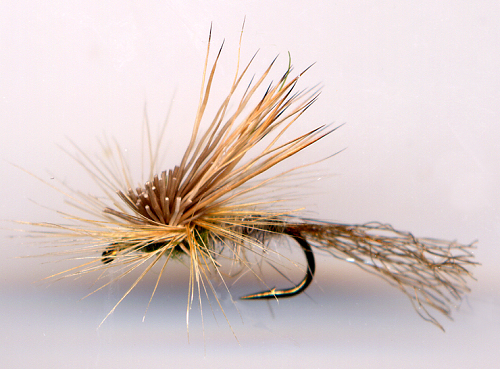
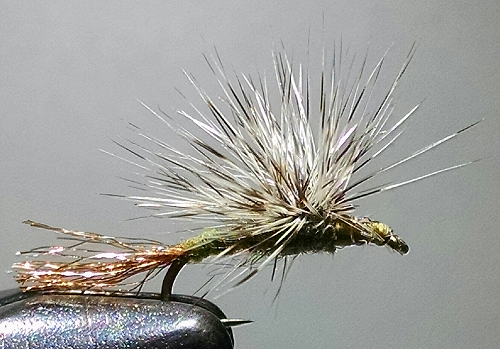


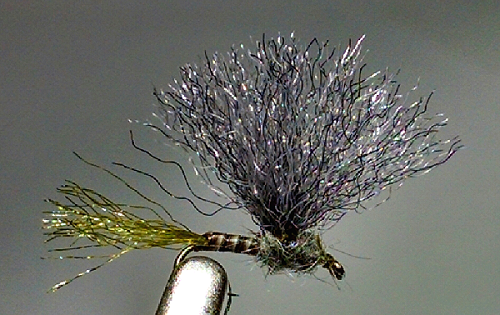

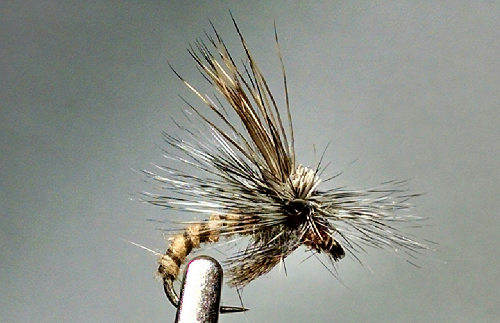

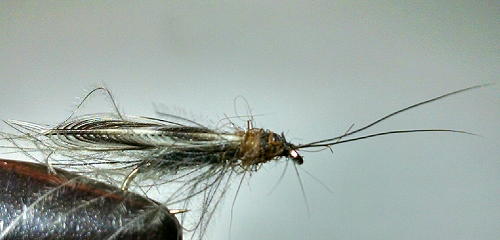
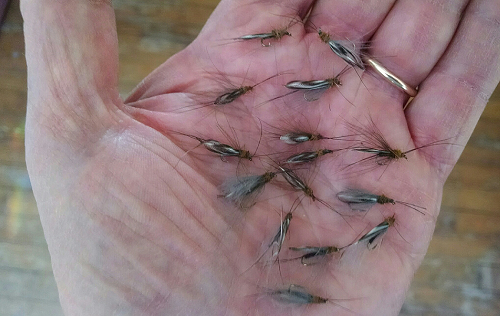
![]()